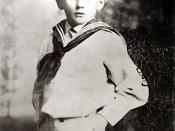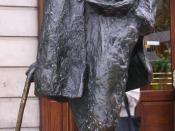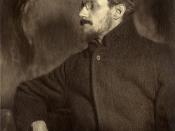James Joyce's short story Araby is a story about a young boy's first love. Joyce suggests that the world in which the boy lives, and the world in which all mankind lives, is a world that is inimical to dreams and ideals. Joyce, through his narrator's description of the street on which he lives, the priest and his belongings, and his subsequent revelation at the Araby bazaar, proposes this darker, deeper revelation of the world.
In Araby the narrator describes his home, and his street in a negative light, showing through imagery the inimical atmosphere of the world. The first object described in the story is North Richmond Street. The street is described as blind, a dead end. Joyce uses the street to show the repressive nature of the neighbourhood on adolescence. The street lamps lift a "feeble"� light to the sky (Joyce, 51) . The streets are described as cold, dark and muddy, hardly the places dreams are made of.
The atmosphere of North Richmond Street is highly oppressive and hazardous. The houses are "imperturbable (Joyce, 51) . The descriptions of the house and the neighbourhood reflect narrow-minded people who are blind to higher values. Joyce uses symbolic description of the homes and the neighbourhood to intentionally reflect upon the domineering force of narrow mindedness on ideals and the isolation that comes from such oppressiveness. Joyce also uses symbolic description in describing the priest and his possessions.
Joyce uses symbolic description of the previous owner of the narrator's house, the priest, and his belongings to show the more vital and imaginative past, an age when stories and myths were encouraged rather than looked down upon as they are in the boy's present. The narrator describes a bicycle pump rusting in the backyard and books whose pages are yellowing with...


